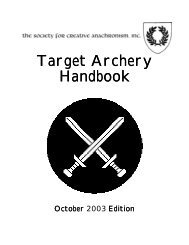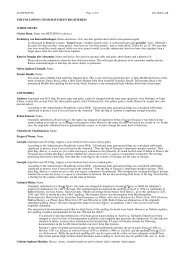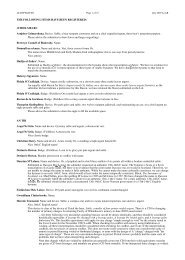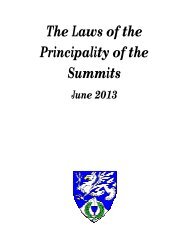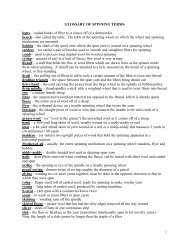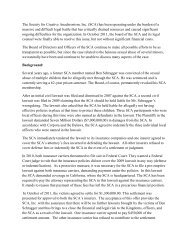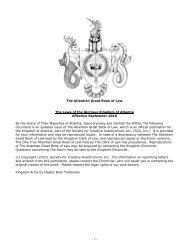The Standards for Evaluation of Names and Armory - SCA Heraldry
The Standards for Evaluation of Names and Armory - SCA Heraldry
The Standards for Evaluation of Names and Armory - SCA Heraldry
Create successful ePaper yourself
Turn your PDF publications into a flip-book with our unique Google optimized e-Paper software.
Appendix B: Types <strong>of</strong> Bynames<strong>The</strong> <strong>St<strong>and</strong>ards</strong> <strong>for</strong> <strong>Evaluation</strong> <strong>of</strong> <strong>Names</strong> <strong>and</strong> <strong>Armory</strong>:<strong>The</strong> Rules <strong>for</strong> SubmissionsA byname is a name phrase added to a given name to specify which William or Mary you're discussing. Bynames fall intoseveral categories, discussed below. For a list <strong>of</strong> the types <strong>of</strong> bynames are available in various languages, see Appendix A.A. Bynames <strong>of</strong> relationship: A byname <strong>of</strong> relationship describes an individual as someone's child or describes some otherimportant relationship. Patronymic names are found widely; other types <strong>of</strong> bynames <strong>of</strong> relationship are far more limitedin their use.1. Patronymic bynames describe someone as their father's son or daughter; they are the most common <strong>and</strong> broadly foundtype <strong>of</strong> byname <strong>of</strong> relationship.Examples include the English Johnson, Williams <strong>and</strong> Robert, the Spanish Perez, the Gaelic mac Néill <strong>and</strong> ingheanDomhnaill, the Scots Makdowall, the Arabic ibn Sulaymān, the German Hainrich, the Italian di Antonio <strong>and</strong> the OldNorse Bjarnarson.2. Historical ancestor bynames describe someone as the descendent <strong>of</strong> their gr<strong>and</strong>father or earlier ancestors: the Gaelic ÓRuairc, inghean Uí Bhriain, <strong>and</strong> the Arabic al-Ḥasanī 'descendant <strong>of</strong> Ḥasan.'Others do the same thing by listing multiple generations: the Gaelic mac Conchobair mhic Fhearchair, the Welsh apRis ap Madoc, <strong>and</strong> the Norse Ketils son Gríms sonar.3. Matronymic bynames describe someone as their mother's son or daughter; these are far less common than patronymicbynames. In Engl<strong>and</strong> they are relatively common, while in Arabic <strong>and</strong> German, they are quite rare. In otherlanguages, they do not happen at all.Examples include: the English Maddison 'Maud's son', filia Agnetis 'daughter <strong>of</strong> Agnes' <strong>and</strong> Rosedoghter; the ArabicIbn Fatimah <strong>and</strong> Ibn al-Labanah 'daughter <strong>of</strong> the milkmaid'; the German Katerinen son; <strong>and</strong> the Italian di Maddalena.4. Other bynames <strong>of</strong> relationship are found only in very limited times <strong>and</strong> places. <strong>The</strong>y include the following:a. Marital bynames describe a woman as her husb<strong>and</strong>'s wife. In most cultures in period, women did not change theirbynames upon marriage (especially bynames <strong>of</strong> relationship: your father doesn't change when you get married).Examples include the Old Norse Végauts kona, the English Jackewyf <strong>and</strong> Hobsonwyf, <strong>and</strong> the Gaelic bean Cormaic.Sometimes marital bynames are identical in <strong>for</strong>m to patronymics like the Italian di Giovanni or German Dieterlins.b. Kunyas are Arabic bynames that describes someone as the parent <strong>of</strong> a child, most frequently their eldest son.Examples include Umm Badr, Abū al-Jafnā 'father <strong>of</strong> the curly haired girl', <strong>and</strong> Abū 'l-Barakāt 'father <strong>of</strong> blessings'.c. Other bynames <strong>of</strong> relationship: Occasionally, someone will be described in terms <strong>of</strong> another relationship. Examplesinclude: English Parsonbrother, Robertstepson, Parsoncosyn, <strong>and</strong> Vikersister. A few Arabic examples have verycomplex descriptions like Ibn ukht Ibn Abi ‘Uqba 'son <strong>of</strong> the sister <strong>of</strong> the man who was the son <strong>of</strong> the father <strong>of</strong>‘Uqba.'d. Work relationships describe someone as someone's current or <strong>for</strong>mer servant. Examples include the EnglishMathewservant, Websterman, Gibmayden <strong>and</strong> Prestewoman as well as the Arabic mawlā Faraj 'freedman <strong>of</strong> Faraj'.B. Locative Bynames: A locative byname describes an individual in terms <strong>of</strong> a place where they were born, they have lived,or are otherwise associated with. We categorize these in two ways: in terms <strong>of</strong> the structure, which can either be aphrase such as <strong>of</strong> London or an adjective like Londoner, <strong>and</strong> in terms <strong>of</strong> whether the locative element is a specific namedplace like London or a generic toponym like Mill or Meadow. Some languages use all <strong>of</strong> these, while others use onlysome <strong>of</strong> these patterns.1. Locative Bynames from Specific Toponyms: Locative bynames are most frequently <strong>for</strong>med from the name <strong>of</strong> a townor city. Locative bynames generally use a single word, though in English there are some examples <strong>of</strong> compound (twoRules <strong>for</strong> Submissions - January, 2012



